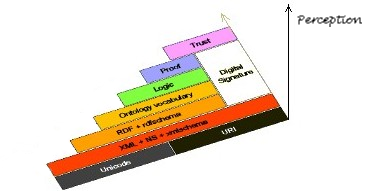| Metalog
Many people don't have a clear idea of what the Semantic Web is. The best informal definition is maybe found in the May 2001 Scientific American article "The Semantic Web" (Berners-Lee et al.), that says "The Semantic Web is an extension of the current web in which information is given well-defined meaning, better enabling computers and people to work in cooperation." People who work on the Semantic Web have a more detailed idea of what this broad statement means, and base their work on the famous "semantic web tower", a product of Tim Berners-Lee's inspiring drawing on whiteboards. Even if you are not a geek, you might have read some article on the semantic web, or followed some presentation, and then you will surely have met the tower, which is a drawing like this

The article or presentation might have then continued by explaining what the "layers" of this tower are, starting from the basic bricks (Unicode and URIs), up to XML, and then up to more and more sophisticated layers like RDF, Ontology and so on.
Now, you might have understood how things work, and have been eagerly awaiting for the realization of this plan. Or, you might not have understood this quite, and have been waiting for someone to show you better what they meant. In fact, the plan as shown in the picture is rapidly taking place: many of the slots are filling up (RDF, RDF Schema, Ontology, Digital Signature). So, the picture as shown is getting completed. Still, most of the people are awaiting, and the Semantic Web has not yet taken off. What's the matter here?
The matter comes from the definition of Semantic Web that we have seen earlier: "The Semantic Web is an extension of the current web in which information is given well-defined meaning, better enabling computers and people to work in cooperation." Now, the sole fact that the tower is filling up with established standards corresponds to the first part of the definition, "an extension of the current web". The fact that these standards work corresponds to a piece of the second part of the definition: "enabling computers to work in cooperation". What is missing, is maybe the most crucial part of the definition: the people. Those people who are awaiting.
So, it's of little importance to those people that the slots work with computers: they want to be part of the game, they want the Semantic Web to fulfill its promise, to enable "computers and people to work in cooperation". Filling up the tower with standards reach the first part of the game, and makes computers happy, but not (yet) people. The tower represents the axis of expressive power, where more and more sophisticated semantics can be encoded. This technical axis doesn't much bother to explicitly take into account the other part of the Semantic Web world. Therefore, a different perspective would be to take that component into proper account, abstracting from the expressiveness axis: let's twist the tower, and build up, orthogonally, a new axis:

The "perception" axis is to signify the abstraction/adaptation of the technologies in the tower, towards the people. To enable their perception by the people. In fact, this axis could have been well named as the "People axis", but perception is maybe a more detailed term. In any case, as both perception and people start with P, this can simply be named as the "P" axis.
The P axis is the one that points towards people, and as such, bases its foundation (talking to computers) in some part of the underlying tower. It is the connection axis between these two worlds, people and computers. This axis is not just made up of applications: just like the expressiveness axis (the "tower") is made by technologies, technologies can well (and should) be first-class citizens in this axis as well. Implementations alone are isolated objects, and can't tell how to communicate with other things. And so, the P axis cannot be left to implementations, leaving the "communication" part just to the underlying tower.
Technologies for the people, in this axis, might sacrifice part of the expressive power given by some underlying technology in the main tower, to build up a technology that is closer to the people. All this, in a standard and interoperable manner. In the overall picture, it's in the P axis that people matter.
[Next to: the PNL interface]